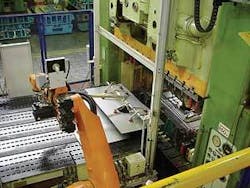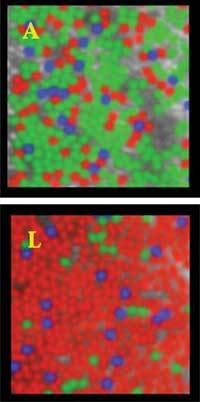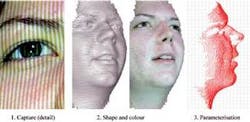Snapshots
Vision guides steel sheets to press
Thyssen Umformtechnik + Guss (Bielefeld, Germany) makes body parts such as fenders and doors for several automotive manufacturers. At its Brackwede plant, the company forms a variety of parts from sheets of steel or aluminum measuring up to 1.2 mm thick. The sheets must be positioned very accurately as they go into the forming press or risk producing unusable parts or damaging the press. Lubricants on the conveyor belt, press, and the parts make tracking and handling the sheets especially difficult, according to Benedikt Laackman, head of body-parts production.
To guide the positioning of the sheets, system integrator VMT Bildverarbeitungssysteme (Weinheim, Germany; www.vmt-gmbh.com) worked with the factory engineers to develop a vision system that would identify each sheet and help a KR 60/P2 robot from KUKA Roboter (Augsburg, Germany; www.kuka-roboter.de) to place up to 4000 sheets a day in the press. The system relies on two CV-M50 cameras from JAI Camera Solutions (Glostrup, Denmark; www.jai.com), with no special lighting, to establish positional accuracy and inspect sheets that vary in length from 800 to 2500 mm. The position of each sheet is calculated by a 350-MHz Pentium II system running Windows NT with a PX-610 PCI frame grabber from CyberOptics Semiconductor (Beaverton, OR, USA; www.imagenation.com), a CAN bus card connecting to the robot controller, and a 17-in. VGA monitor. VMT CEO Harald Mikeska says the software is a combination of VMT tools and Common Vision Blox from Stemmer Imaging (Puchheim, Germany; www.stemmer-imaging.de).
Brain controls color perception
In the first imaging of living human retinas, researchers at the University of Rochester (Rochester, NY, USA; www.rochester.edu) have found that the number of color-sensitive cones in the human retina differs dramatically among people-by up to 40 times-yet people appear to perceive colors the same way. The findings, published in theJournal of Neuroscience, strongly suggest that the perception of color is controlled much more by brains than by eyes.
David Williams, Allyn Professor of Medical Optics and director of the Center for Visual Science, and his research team used a laser-based adaptive-optics system to image the topography of the inner eye and precisely count the color-receptive cones in a living human eye for the first time. Imaging the living retina allowed the researchers to shine light directly into the eye to see what wavelengths each cone reflects and absorbs and, thus, to which color each is responsive.
Fraunhofer offers adaptive optics kit
Originally developed for astronomy, adaptive-optics techniques can be used for imaging through biological tissue in optical microscopy or for any kind of object recognition in machine vision. Fraunhofer IPMS (Dresden, Germany; www.ipms.fraunhofer.de) has developed a complete MEMS phase former kit for adaptive optics. The key component is a high-resolution MEMS micromirror array of 240 × 200 piston-type mirror elements with 40-μm pixel size providing 400-nm stroke at 8-bit resolution. Full user programmability and control are established by driver software.
An IEEE 1394a FireWire interface with an electronic driving board allows for maximum frame rates up to 500 Hz. To visualize the potential for optical imaging enhancement, a complete demonstrator system contains a projection system in which objects of different complexity are imaged through adaptive optics onto a CCD camera. Phase errors are introduced by rotating phase plates. Using a Shack-Hartmann sensor and the MEMS micromirror for wavefront sensing and correction, respectively, the obtainable imaging improvement can be assessed by means of the recorded CCD picture, which is also projected onto a large screen.
Face recognition fits 3-D pattern
Airport check-in may change if UK trials of a high-speed 3-D face imaging system are successful. The technology, being developed at Sheffield Hallam University’s Materials and Engineering Research Institute (MERI; www.shu.ac.uk/research/meri/gmpr/) by a team led by Marcos Rodrigues, passes a single pattern of light over the face creating a 2-D image from which 3-D data are generated. A “parameterization” process, providing an accurate digital map of the face, then extracts biometric features.
Some 3-D face-recognition systems require 16 shots of the face, proving unworkable because of the time it takes to construct a picture and the chance of movement during such a multishot process. Rodrigues says that hardware requirements for the new system are a projector and a single camera, making setup inexpensive. The MERI system measures the distance over the surface of the face rather than from one line to another, which enables it to extract 40-100 parameters rather than the six that older systems provide.
Since the light is passed over the face in 40 ms, the system could be used like a metal detector, capturing a number of images in 3 or 4 s as a person walks past, with the best image chosen automatically. The researchers say that the speed of the process will open up new applications in security and authorization, and they want to explore using the system in industrial applications for monitoring and control. “Objects can go on a conveyor belt, and, instead of using a flat image, a 3-D image can help locate defects. Although we are focusing on security applications now, there is great potential in the future,” says Rodrigues.



